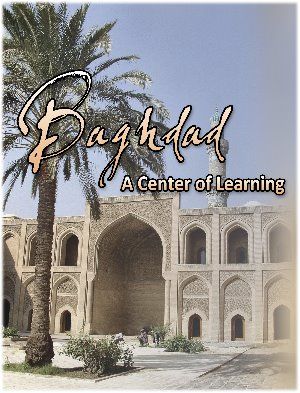Foundation
Abbasid Caliph al-Mansur founded Baghdad on July 20, 762 C.E., intending it to serve as the capital of Islam and calling it “Madinat-us-Salaam,” or City of Peace. Baghdad was also known as the Round City because it was constructed in a circular shape, consisting of towering semi-circle city walls on the right and left banks of the Tigris River. At the center was a large square with the mosque on one end and the caliph palace on the other; along the inside of the city walls were residential and commercial structures.
Baghdad was designed in such a way that it was able to utilize the two major river systems in the area: the Tigris and the Euphrates. This strategic and geographic advantage enabled Baghdad to control trading routes and also provided its inhabitants with a plentiful supply of water.
“The Tigris River and a system of canals gave the city access to the sea, and its trade and manufacture brought an enormous accumulation of wealth. Its palaces, mosques, schools, and public buildings were the wonder of the world,” according to F.B. A
rtz, author of The Mind of the Middle Ages.
Indeed, Baghdad became renowned not only for its size, shape and affluence, but also for its nurturing of the arts, sciences, and education.

A Center for Learning
As the city of Baghdad grew, it developed a reputation for learning and research. Scholars from all across the Islamic world were attracted to Baghdad, quickly turning it into an intellectual hub. This was no surprise because Islam puts so much emphasis on acquiring knowledge.
In fact, the very first verses revealed to Prophet Muhammad (pbuh) enjoined him to read, and informed him that God taught man everything that he never knew before. At another place, God exhorts the believers to ask Him: “O my Lord! Increase me in knowledge.” (20:114) Furthermore, God constantly tells humankind to reason, to reflect, to analyze throughout the Quran.
The Prophet himself is known to extol the benefits of knowledge and wisdom. For example, he once said, “The seeking of knowledge is obligatory upon every Muslim.” (Baihaqi) Additionally, he has stated, “He who goes forth in search of knowledge is in the way of Allah till he returns.” (Tirmidhi) Prophet Muhammad (pbuh) valued literacy so much that he would promise literate prisoners of war freedom if they taught Muslims how to read and write.
Hence, Islam provided the necessary platform and support, leading to wondrous discoveries, inventions, and developments.
Library
Muslims learned how to make paper from the Chinese, and proceeded to transform this art into a major industry. By 793 C.E., there were many paper mills in Baghdad. This was a revolutionary development because the existing alternatives to paper were papyrus, which was fragile, and parchment, which was expensive; paper, on the other hand, was relatively cheap. This mass availability of paper enabled Muslims to commit vast amounts of translations and original research to paper; as a result, libraries and bookstores became a common sight in Baghdad, and soon spread to other Muslim cities.
By the thirteenth century, Baghdad had thirty-six libraries and a 100 book dealers, some of whom were also publishers. The concept of a library catalog dates back to this period; books in these libraries were organized under specific genres and categories. Besides these, many nobles and merchants had private collections of books.
“We hear of a private library in Baghdad, as early as the ninth century, that required a hundred and twenty camels to move it from one place to another. Another scholar of Baghdad refused to accept a position elsewhere because it would take four hundred camels to transport his books; the catalogue of this private library filled ten volumes. This is the more astonishing when it is realized that the library of the king of France in 1300 had only about four hundred titles,” writes Artz in his book, The Mind of the Middle Ages.
In addition to libraries and bookshops, the Muslims of Baghdad established an academy devoted to research and intellectual enhancement followed by an institution which is widely acknowledged as the precursor to the modern university, and the very first hospital.
House of Wisdom
Caliph Haroon al-Rasheed is credited with expanding the glory of Baghdad to its greatest height during his reign from 786 to 809 C.E. He created an intellectual ambience by encouraging mathematicians, astronomers, scientists, and philosophers. His son, Caliph al-Mamoon went a step further by establishing the House of Wisdom in, an academic institute devoted to translations, research, and education. It quickly became one of the most famous centers of learning, attracting scholars from all over the world, from many cultures and religions. Here, teachers and students worked together to translate Greek, Persian, Syriac and Indian manuscripts. They studied the works of Aristotle, Plato, Hippocrates, Euclid, Ptolemy, Pythagoras, Brahmagupta and many others. Then, they began building on and testing the knowledge of the greatest ancient scholars, resulting in the development of the scientific method of observation and experimentation.
Instruction at the House of Wisdom included rhetoric logic, metaphysics, theology, algebra, geometry, trigonometry, physics, biology, medicine, and surgery, as documented by Artz. The House of Wisdom also housed an observatory which facilitated astronomical advancements, leading to refinements of such scientific tools as the astrolabe. Scholars also extended the known bounds of existing fields of study – introducing chemistry, algebra, and launching trigonometry as a proper branch of mathematics.
University
During the later part of the 11th century, Baghdad introduced the precursor to the modern university in the form of a chain of madrasahs which housed students and a salaried faculty. They were known as the Nizamiyah, after their founder Nizam al-Mulk, a Seljuk vizier. The largest and most splendid of these was located in Baghdad; the great theologian al-Ghazali and the celebrated historian of Saladin, Baha Eddin, were lecturers there.
The al-Mustansiriyah college was established in 1234 C.E. by Caliph al-Mustansir. It was a large two-storied building, oblong in shape, with a courtyard in the center. Housing and food were provided for those students who required it. The curriculum included religious studies, mathematics, medicine, and history, among other subjects.
Hospital
The modern hospital has its roots in a similar institution as established by the Abbasids in Baghdad, something hitherto unheard of. The first hospital was founded in 914 C.E. Another hospital was built in 918 C.E. at the behest of Caliph Muqtadir. Among the physicians here was the renowned Al-Razi (Rhazes). Doctors treated and studied the patients, and documented their findings.
“By the year 1000, five major hospitals will have been built in Abbasid Baghdad. These hospitals will serve multiple purposes, not unlike modern hospitals containing surgery centers, outpatient clinics, psychiatric wards, convalescent centers, and even nursing homes. And quite often they are free to those in need,” writes Michael Hamilton Morgon in Lost History, the Enduring Legacy of Muslim Scientists, Thinkers, and Artists.
Decline of Baghdad
By the thirteenth century, the caliphate had weakened due to internal rivalries and a decadent lifestyle. In the wake of such fragmentation, the Mongols attacked in 1258 and devastated the city and its inhabitants. The civilized people of Baghdad were horrified at the savage ways of the Mongols who resorted to mass murders, pillaging, and mindless destruction. Its libraries, foremost among the treasures of Baghdad, were burned down. Its canals were destroyed. Its great historical monuments were forever ruined.
“For five hundred years, Baghdad had been a city of palaces, mosques, libraries and colleges. Its universities and hospitals were the most up to date in the world. Nothing now remained but heaps of rubble and a stench of decaying human flesh,” recounts Sir John Glubb in A Short History of the Arab Peoples.
The city thus began a long period of decline, falling victim to subsequent wars that continue to this day. However, during its five centuries of glory, it gifted the world an immense treasure which became the foundation for the European Renaissance. Just as the Muslims had translated ancient works into Arabic centuries before, the Europeans began translating Arabic scholarship into Latin, giving Latinized names to Muslim scholars, and advancing their research. This salvaged knowledge formed the basis for the Age of Enlightenment.
In fact, Islam was the major catalyst which enabled Baghdad to reach its glorified stature. In addition to encouraging the gathering of knowledge and the use of reasoning, Islam was more than just a religion. Being a “way of life”, it was not confined to the mosque but was apparent in everyday activities of people. The Muslims of Baghdad refined astronomy as a science in order to offer their five daily prayers at accurate times, to predict when the crescent moon will appear, to find the direction to Mecca for prayers; in the process, and to achieve these aims, they perfected the astrolabe. The Quran specified with clarity that God’s Universe was not random, a mere chance, but was created with wisdom and purpose. This led many scientists to consider the entire world as their research field, resulting in numerous astronomical, mathematical, and geographical discoveries.
Islam also taught human beings that they were free from Original Sin, leading Muslims to believe in the inherent goodness of humans; this modern outlook enabled scientists to study disease in a matter-of-fact manner. Therefore, as explained by Michael Hamilton Morgan in Lost History, “disease [had] specific, scientifically based physical causes. It [was] not a punishment visited on men from God.”
Furthermore, the Quran declares, “O Mankind, We created you from a single (pair) of a male and a female and made you into nations and tribes, that you may know each other. Verily the most honored of you in the sight of God is he who is the most righteous of you.” (49:13) This universalism of Islam allowed it to expand its borders. Muslim scientists were eager to learn from people of other cultures and faiths, which is apparent in the prolific translations which took place during this period. On the whole, their faith facilitated them and provided them with a strong foundation which propelled them to reach new heights in their chosen fields.
Today, Iraq is poised on the road toward independent rule and has yet another chance to reclaim its glorious days. Baghdad can once again rise from the ashes of its tumultuous recent past – as it has done many times before. This time, it should aim to regain its historical place of intellectual and scientific pursuits along with establishing itself as a center of trade and commerce, keeping in mind the debt it owes to Islam and its ancestral Muslims.
by Saulat Pervez




